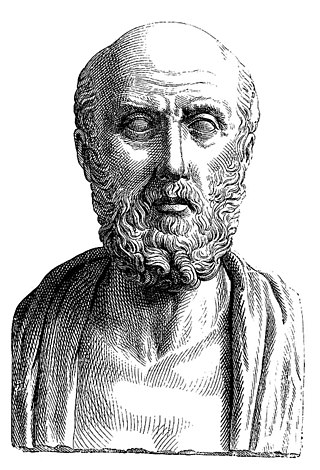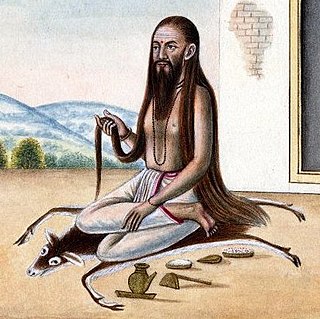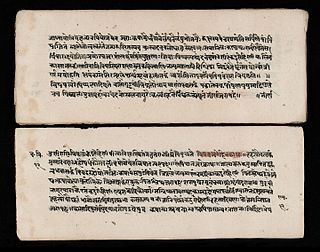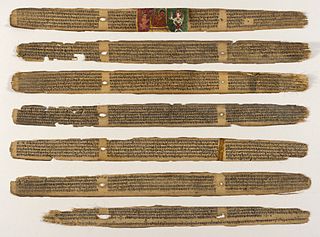Related Research Articles

The Hippocratic Oath is an oath of ethics historically taken by physicians. It is one of the most widely known of Greek medical texts. In its original form, it requires a new physician to swear, by a number of healing gods, to uphold specific ethical standards. The oath is the earliest expression of medical ethics in the Western world, establishing several principles of medical ethics which remain of paramount significance today. These include the principles of medical confidentiality and non-maleficence. As the seminal articulation of certain principles that continue to guide and inform medical practice, the ancient text is of more than historic and symbolic value. It is enshrined in the legal statutes of various jurisdictions, such that violations of the oath may carry criminal or other liability beyond the oath's symbolic nature.

Bharadvaja was one of the revered Vedic sages (maharishi) in Ancient India. He was a renowned scholar, economist, grammarian and physician. He is one of the Saptarishis.

Charaka was one of the principal contributors to Ayurveda, a system of medicine and lifestyle developed in ancient India. He is known as a physician who edited the medical treatise entitled Charaka Samhita, one of the foundational texts of classical Indian medicine and Ayurveda, included under Brhat-Trayi.
Vāgbhaṭa (वाग्भट) is one of the most influential writers, Scientist, Doctor and advisor of ayurveda. Several works are associated with his name as author, principally the Ashtāṅgasaṅgraha (अष्टाङ्गसंग्रह) and the Ashtāngahridayasaṃhitā (अष्टाङ्गहृदयसंहिता). The best current research, however, argues in detail that these two works cannot be the product of a single author. Indeed, the whole question of the relationship of these two works, and their authorship, is very difficult and still far from solution. Both works make frequent reference to the earlier classical works, the Charaka Samhita and the Sushruta Samhita. Vāgbhaṭa is said, in the closing verses of the Ashtānga sangraha to have been the son of Simhagupta and pupil of Avalokita. His works mention worship of Cows and Brahmanas and various Vedic Gods, he also begins with a note on how Ayurveda evolved from Brahma. His work contains syncretic elements.
Agnivesha is a legendary rishi (sage) in Hinduism, reputedly one of the earliest authors on Ayurveda. He is described to have codified the knowledge of his preceptor, Atreya, and arranged it in the form of a treatise, named the Charaka Samhita.

The Charaka Samhita is a Sanskrit text on Ayurveda. Along with the Sushruta Samhita, it is one of the two foundational texts of this field that have survived from ancient India. It is one of the three works that constitute the Brhat Trayi.

The Sushruta Samhita is an ancient Sanskrit text on medicine and surgery, and one of the most important such treatises on this subject to survive from the ancient world. The Compendium of Suśruta is one of the foundational texts of Ayurveda, alongside the Charaka-Saṃhitā, the Bhela-Saṃhitā, and the medical portions of the Bower Manuscript. It is one of the two foundational Hindu texts on the medical profession that have survived from ancient India.
The Bṛhat-Trayī, literally translated as "The Great Triad ", refers to three early Sanskrit encyclopaedias of medicine, which are the core texts of the indigenous Indian medical system of Ayurveda. These are contrasted with the Laghu-Trayī or the "lesser triad", a secondary set of later authoritative compositions.
Kashyap Samhitā, also known as Vriddha Jivakiya Tantra is a treatise on Ayurveda attributed to the sage Kashyapa.

Sushruta, or Suśruta is the listed author of the Sushruta Samhita, a treatise considered to be one of the most important surviving ancient treatises on medicine and is considered a foundational text of Ayurveda. The treatise addresses all aspects of general medicine, but the impressive chapters on surgery have led to the false impression that this is its main topic. The translator G. D. Singhal dubbed Suśruta "the father of plastic surgery" on account of these detailed accounts of surgery.
In Ayurvedic medicine, the compilation of traditional ancient Indian medicine practice is called rasaśāstra(रसशासत्र ), which details processes by which various metals, minerals and other substances, including mercury, are purified and combined with herbs in an attempt to treat illnesses. Rasashastra is a pharmaceutical branch of Indian system of medicine which mainly deals with the metals, minerals, animal origin product, toxic herbs and their use in therapeutics.
Atreya (आत्रेय) Rishi, or Atreya Punarvasu, was a descendant of Atri, one of the great Hindu sages (rishis) whose accomplishments are detailed in the Puranas. Sage Atreya was a renowned scholar of Ayurveda, and a school of early Ayurveda was founded based on his teachings.

Shalihotra was a veterinarian and writer. His work, the Shalihotra Samhita, is an early Indian treatise on veterinary medicine (hippiatrics), likely composed in the 3rd century BCE.

Hindu architecture is the traditional system of Indian architecture for structures such as temples, monasteries, statues, homes, market places, gardens and town planning as described in Hindu texts. The architectural guidelines survive in Sanskrit manuscripts and in some cases also in other regional languages. These texts include the Vastu shastras, Shilpa Shastras, the Brihat Samhita, architectural portions of the Puranas and the Agamas, and regional texts such as the Manasara among others.

Uday Chand Dutt or Udoy Chand Dutt (1834-1884) was a physician and expert on Ayurveda who served as a civil medical officer at Serampore, Bengal, India and wrote the Materia Medica of the Hindus, a major translation of Sanskrit works into English, first published in 1870. This book included translations of a number of Sanskrit sources on traditional Indian medicine into English and later revisions included a glossary of the botanical names was provided by Sir George King. Dutt helped Sir George Watt in producing his Dictionary of the economic plants of India and his work is widely cited. An edition in 1877 included revisions by Binod Lall Sen, Kaviraj Ashutosh Sen, and Kaviraj Pulin Krishna Sen (Kavibhushan).
Vaidya Bhagwan Dash was an Indian author and scholar in the field of Ayurvedic and Tibetan Medicine.
Gangadhar Sen Roy was a Bengali Ayurvedic doctor, poet and Sanskrit scholar.
Gurdip Singh is a professor from Gwalior, India. He is a senior professor of Ayurveda and the Director of Post Graduate Studies at the SDM College of Ayurveda and Hospital in Hassan, Karnataka. He is considered an authority on the Ayurveda work Charaka Samhita. Singh was a dean of Institute for Post Graduate Teaching and Research in Ayurveda at Gujarat Ayurved University at Jamnagar, Gujarat.

Institute of Teaching and Research in Ayurveda (ITRA) Jamnagar, Gujarat, India which was founded in 1967. It has a joint campus with, an Institute of National Importance, established in 2020.
Bhela Samhita is a Sanskrit-language medical text from ancient India. It is known from an incomplete c. 1650 CE manuscript kept at the Sarasvati Mahal Library in Thanjavur, and a c. 9th century fragment found at Tuyoq. Quotations in other works suggest that an older version of the text, possibly composed during 400-750 CE, existed.
References
- ↑ A. V. R. Murthy, Dhanya C. P. (November 2018). "The Medical Oath of Cosecration of Ancient India" (PDF). Journal of Vishwa Ayurved Parishad: 9–16. Archived from the original (PDF) on 14 February 2022. Retrieved 14 February 2022.
- ↑ The Caraka Samhita. Jamnagar, India: Shree Gulabkunverba Ayurvedic Society. 1949. pp. 865–871. Retrieved 14 February 2022. (Note: The Caraka Samhita expounded by the worshipful Atreya Punravasu, compiled by the great sage Agnivesa and redacted by Caraka and Dridhabala. Edited and published in six volumes with translations in Hindi, Gujarati and English.)
- ↑ I A Menon and H F Haberman (July 1070). "The medical students' oath of ancient India". Med. Hist. 4 (3): 295–299. doi:10.1017/s0025727300015593. PMC 1034061 . PMID 4921981.
- ↑ "चरकसंहिता". e-Samhita. Central Council for Research in Ayurveda and Siddha (CCRAS), New Delhi. Retrieved 14 February 2022.
- ↑ The Wire staff. "Medical Commission Board Proposes To Replace Hippocratic Oath With 'Charak Shapath'". Science : The Wire. The Wire. Archived from the original on 2022-03-14. Retrieved 14 February 2022.
- ↑ FP Staff. "Explained: What the Hippocratic Oath is and proposal of replacing it with Charak Shapath". Firstpost. Firstpost. Archived from the original on 2022-03-14. Retrieved 14 February 2022.
- ↑ Bobins Abraham (11 February 2022). "Doctors Angry Over Alleged Proposal To Replace Hippocratic Oath With 'Charak Shapath'". India Times. Retrieved 14 February 2022.
- ↑ Staff Reporter (13 February 2022). "Kerala IMA opposes 'Maharshi Charak Shapath'". The Hindu. Archived from the original on 2022-03-14. Retrieved 14 February 2022.